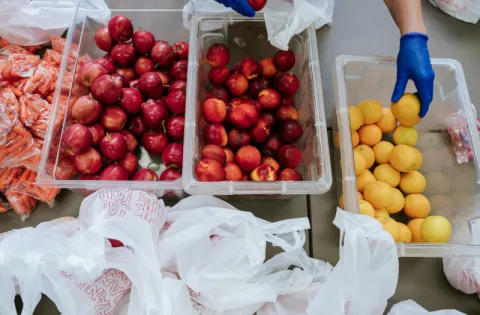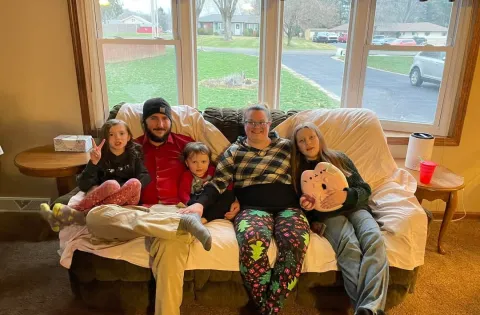Last week, the White House released its budget for fiscal year 2021. This wish list proposes deep cuts to safety net programs like SNAP, Child Nutrition, Medicaid, housing assistance and student loans. Taken individually, each of these cuts would be a hard blow to low-income families. Taken together, they’re devastating. If enacted, these budget cuts would make it harder for low-income families to get back on their feet during tough times and make it more difficult for Americans move out of poverty. No Kid Hungry stands in strong opposition to this budget proposal.
Here’s everything you need to know.
This is what the White House proposed
Among a host of shortsighted and ill-conceived changes it would:
- Cut SNAP
The Supplemental Nutrition Assistance Program (SNAP) is one of our nation’s most powerful tools to end hunger, especially for children. This budget cuts SNAP funding by $180 billion (nearly 30%) over 10 years. It also proposes to replace a portion of SNAP benefits with so-called “Harvest Boxes,” which are shipments of pre-selected shelf stable food. This not only eliminates family meal choice, but it also disregards the local economic benefits the SNAP program currently provides and SNAP’s efficiency and low administrative costs.
- Hurt child nutrition programs
It also seeks to cut child nutrition programs, like school meals, by $20 million in the first year and $1.7 billion over 10 years. This would put recent progress to end childhood hunger at real risk. Given the significant body of research reinforcing the impact nutrition has on children’s health and development, education performance and even lifetime earnings, these cuts come with a high price tag.
- Slash Medicaid
Medicaid is a critical program that provides health care for the poor and for people with disabilities. It currently covers 1 in 5 Americans. This budget proposes cutting the program by $1 trillion, including eliminating federal matching funds, that could put health care coverage at risk for 13 million people. The result: less health coverage and more chronic and acute illnesses.
- Hurt housing assistance programs
For many families, the cost of living outpaces household wages, putting them at risk for homelessness. Housing assistance programs help ensure stability for low-income families and puts a roof over their heads. The President’s budget proposes cutting funding for public housing by 43% and eliminating housing vouchers for 160,000 low-income households. It would also eliminate Choice Neighborhoods, Community Development Block Grant and HOME Investment Partnerships programs, which support the building and rehabilitation of affordable housing.
This budget also seeks to eliminate the Low Income Home Energy Assistance Program (LIHEAP), which helps low-income families pay their energy bills and keep their homes warm during cold months.
- Eliminate afterschool programs
Afterschool programs provide a safe place for young people to participate in academic and extracurricular enrichment activities. They help kids improve educational outcomes, develop new hobbies and skills, and ultimately help working families make ends meet. This budget would eliminate funding the 21st Century Community Learning Centers, an initiative in the U.S. Department of Education that helps states serve 1.7 million low-income children.
- Devastate student loan assistance
The budget would also slash $170 billion from student loan programs, partly by eliminating subsidized federal student loans and ending the public service loan forgiveness program, which helps our nation’s hardworking public service professionals like teachers, nurses and first responders.
Here’s the big picture
Millions of Americans live paycheck-to-paycheck, one emergency expense away from food insecurity. In fact, according to the Federal Reserve, 4 out of 10 Americans couldn’t come up with $400 for an emergency expense, like a medical bill, without selling something or borrowing money. When you struggle to pay for your very basic needs juggling housing, health care, transportation and education, food security becomes unintended collateral damage.
Food is one of the easiest things to cut from the budget when a family feels financial security slip and the proverbial purse strings tighten. That’s why it’s so important that we invest in the nutrition programs that feed kids. When we make sure kids have the nutrition they need at school, at home and during the summer, we’re ensuring they’re growing up healthy, educated and able to escape the cycle of poverty.
So, are these cuts actually going to happen?
Not necessarily. The President’s budget is unlikely to be passed into law. It’s more of a wish list that provides Congress and the American public a blueprint of the Administration’s priorities. Congress is responsible for enacting government spending bills and both the House and the Senate would have to agree to these cuts for them to become law.
The Administration has been turning to the regulatory process to achieve its desired changes to the SNAP program. Over the last year, three new rules have been proposed that create stricter work requirements for program eligibility, cap deduction for utility allowance and limit access to SNAP for working poor families. According to the Center on Budget and Policy Priorities, these three rules would cut SNAP by about $50 billion over 10 years, end SNAP benefits for 3 to 4 million people and reduce benefits for about 6-7 million others.
What happens next?
We now look to the House and Senate Budget Committees, who will each draft a budget resolution of their own. This is the first step in a long process to finalize federal spending for FY 2021, which begins October 1st.
Here’s how you can help.
Call your Senators and your Representatives in Washington, DC and tell them to stand up against the President’s Budget and to protect the programs that help feed, shelter, educate and keep our nation’s children healthy. Here’s how you can get in touch with your Member of Congress.


